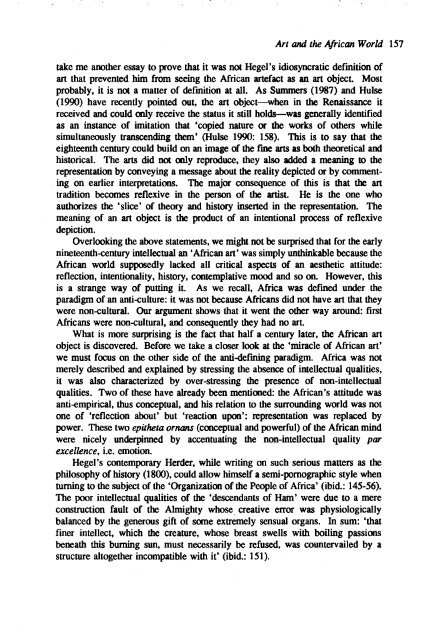1991 No. 1 CONTENTS - Institute of Social and Cultural ...
1991 No. 1 CONTENTS - Institute of Social and Cultural ...
1991 No. 1 CONTENTS - Institute of Social and Cultural ...
Create successful ePaper yourself
Turn your PDF publications into a flip-book with our unique Google optimized e-Paper software.
Art <strong>and</strong> the African World 157<br />
take me another essay to prove that it was not Hegel's idiosyncratic definition <strong>of</strong><br />
art that prevented him from seeing the African artefact as ~ art object Most<br />
probably, it is not a matter <strong>of</strong> defmition at all. As Summers (1987) <strong>and</strong> Hulse<br />
(1990) have recently pointed out, the art object-When in the Renaissance it<br />
received <strong>and</strong> could ooly receive the status it still holds-was generally identified<br />
as an instance <strong>of</strong> imitation that 'copied nature or the works <strong>of</strong> others while<br />
simultaneously transcending them' (Hulse 1990: 158). This is to say that the<br />
eighteenth century could build on an image <strong>of</strong> the fme arts as both theoretical <strong>and</strong><br />
historical. The arts did not ooly reproduce, they also added a meaning to the<br />
representation by conveying a message about the reality depicted or by comment-<br />
. ing on earlier interpretations. The major consequence <strong>of</strong> this is that the art<br />
tradition becomes reflexive in the person <strong>of</strong> the artist. He is the one who<br />
authorizes the 'slice' <strong>of</strong> theory <strong>and</strong> history inserted in the representation. The<br />
meaning <strong>of</strong> an art object is the product <strong>of</strong> an intentional process <strong>of</strong> reflexive<br />
depiction.<br />
Overlooking the above statements, we might not be surprised that for the early<br />
nineteenth-century intellectual an 'African art' was simply unthinkable because the<br />
African world supposedly lacked all critical aspects <strong>of</strong> an aesthetic attitude:<br />
reflection, intentionality, history, contemplative mood <strong>and</strong> so on. However, this<br />
is a strange way <strong>of</strong> putting it. As we recall, Africa was defined under the<br />
paradigm <strong>of</strong> an anti-culture: it was not because Africans did not have art that they<br />
were non-cultural. Our argument shows that it went the other way around: first<br />
Africans were non-cultural, <strong>and</strong> consequently they had no art.<br />
What is more surprising is the fact that half a century later, the African art<br />
object is discovered. Before we take a closer look at the 'miracle <strong>of</strong> African art'<br />
we must focus on the other side <strong>of</strong> the anti-defming paradigm. Africa was not<br />
merely described <strong>and</strong> explained by stressing the absence <strong>of</strong> intellectual qualities,<br />
it was also characterized by over-stressing the presence <strong>of</strong> non-intellectual<br />
qualities. Two <strong>of</strong> these have already been mentioned: the African's attitude was<br />
anti-empirical, thus conceptual, <strong>and</strong> his relation to the surrounding world was not<br />
one <strong>of</strong> 'reflection about' but 'reaction upon': representation was replaced by<br />
power. These two epitheta ornons (conceptual <strong>and</strong> powerful) <strong>of</strong> the African mind<br />
were nicely underpinned by accentuating the non-intellectual quality par<br />
excellence, i.e. emotion.<br />
Hegel's contemporary Herder, while writing on such serious matters as the<br />
philosophy <strong>of</strong> history (1800), could allow himself a semi-pornographic style when<br />
turning to the subject <strong>of</strong> the 'Organization <strong>of</strong> the People <strong>of</strong> Africa' (ibid.: 145-56).<br />
The poor intellectual qualities <strong>of</strong> the 'descendants <strong>of</strong> Ham' were due to a mere<br />
construction fault <strong>of</strong> the Almighty whose, creative error was physiologically<br />
balanced by the generous gift <strong>of</strong> some extremely sensual organs. In sum: 'that<br />
finer intellect, which the creature, whose breast swells with boiling passions<br />
beneath this burning sun, must necessarily be refused, was countervailed by a<br />
structure altogether incompatible with it' (ibid.: 151).
















